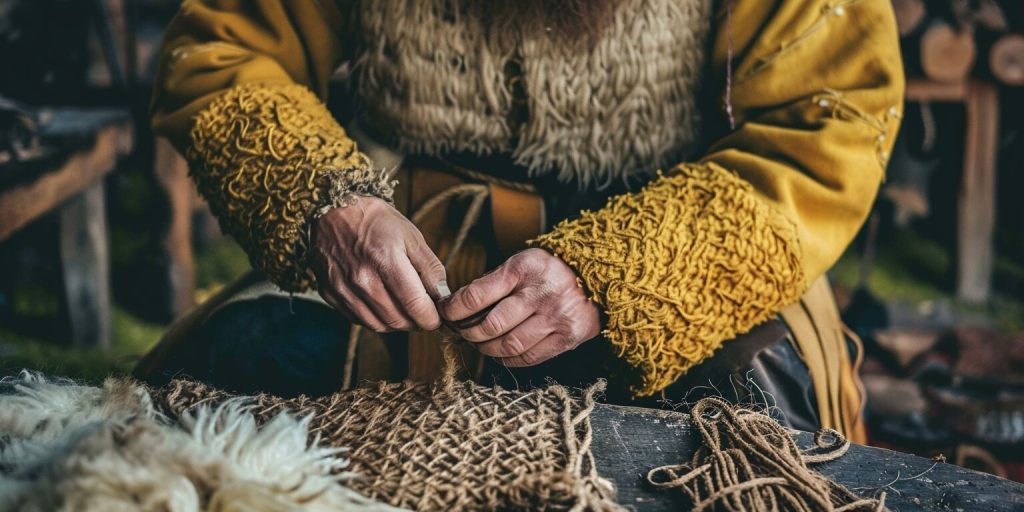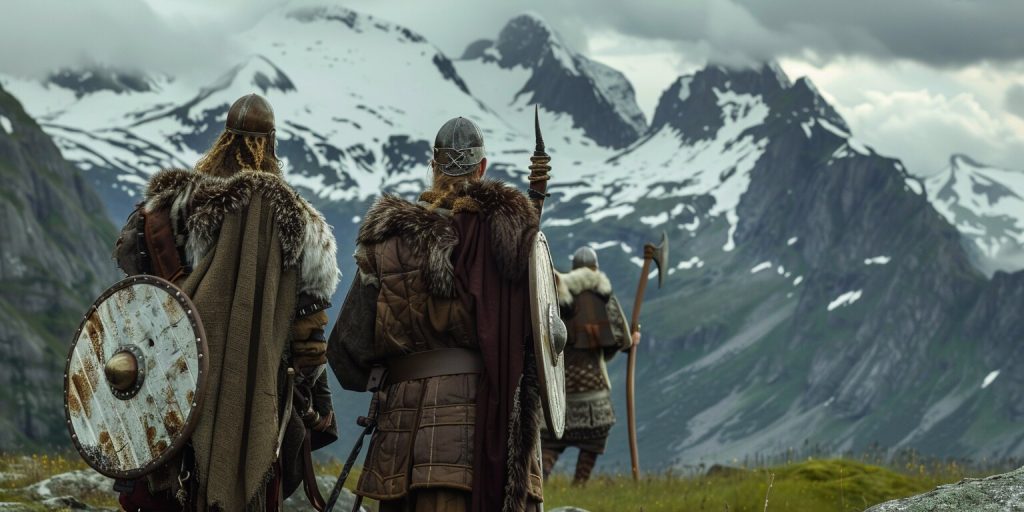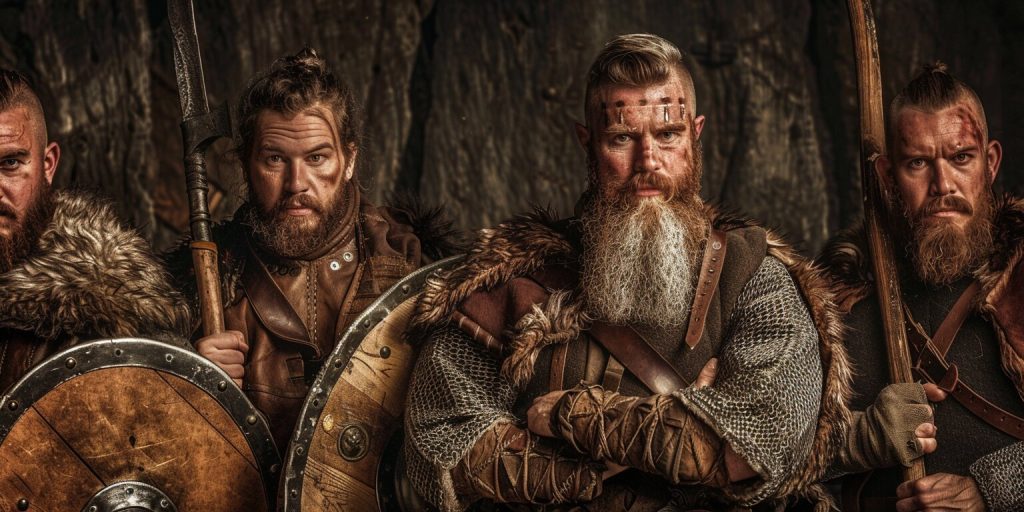Daily Life in the Viking Age, Viking Clothing and Jewelry, Vikings
Historically Accurate Viking Clothing: Top 5 Facts
Viking clothing gives us a peek into their fashion and style. It shows us the materials, designs, and techniques they used, allowing us to see how the Norse people dressed back then.
Viking clothing historical was more than just fashion. It had to be tough, warm, and practical for the cold north. That’s why they used wool a lot. It kept them warm even when wet.
For history lovers and Viking fans, wearing authentic historical Viking warrior clothing is a dream come true. It lets them enter the Viking world and experience what life was like back then.
What Did Vikings Wear in the 9th Century?
Viking Tunic and Cloak
In the Viking Age, from the late 8th to the 11th century, clothes were key to showing social status and identity. The tunic was a key piece of clothing for Vikings in the 9th century. It was loose-fitting, made of wool, and very practical.
Vikings of all social levels, both men and women, wore tunics made from quality wool. These tunics kept people warm in the cold Scandinavian weather and were easy to move in, perfect for daily tasks.
The tunic’s length and style changed based on the wearer’s gender, social status, and personal choice. Men wore tunics that reached their knees, while women’s tunics went down to the ankle. Decorative trimmings on the neckline showed off the wearer’s style.
On top of their tunics, Vikings wore a wool cloak, often fastened with a brooch. This cloak was for extra warmth and as a fashion statement. It was put over the shoulders and held together with a brooch or pin.
To keep their clothes in place, Vikings used belts. These belts were not just useful; they also made their outfits look better and were a key component of Viking costumes. Made of leather or fabric, they often had metal buckles or carved decorations.
How Were Viking Clothes Made?
Viking Textile and Sewing Techniques
In the Viking Age, clothing was key to the Norse people’s lives. It was not just for keeping warm but also to show who you were and your social status. Let’s dive into how Viking clothes were made.

Textile Production
Viking clothes came from natural materials like wool and linen. Wool kept people warm and was strong, perfect for the cold Scandinavian weather. Linen was for lighter clothes that let air in.
Making textiles was a big deal in Viking society. They started by spinning fibers together to make yarn. Then, they wove this yarn into fabric using looms, which were essential for creating Viking dresses. They knew how to use both horizontal and warp-weighted looms.
Tablet weaving was another technique they used. It involved using small cards with holes to make patterns in the fabric. By changing the cards, weavers could make beautiful designs for clothes.
Sewing Techniques
Vikings used simple stitches to sew their clothes. The overcast stitch was common for securing fabric edges. Seams were sewn together with a running stitch, going in and out of the fabric in a straight line.
Brooches and other metal, bone, or glass fasteners were used to decorate and secure clothes. They were often used to fasten parts of Viking dress, adding style and personal touches to the clothing.
Fur was added to Viking clothes for warmth. They prepared animal pelts and sewed them onto garments, keeping people warm in the cold Scandinavian winters.
Vikings colored their clothes using natural plant, insect, and mineral dyes. These dyes produced vibrant colors that enhanced Viking outfits. The dye was applied using immersion dyeing or stamping.
Vikings made a variety of clothes using their skills in textiles and sewing. Their work shows the style, function, and social importance of their clothing. Today, their craftsmanship inspires people to make their own Viking clothes, incorporating elements of traditional Viking dress.
Why Were Viking Trousers and Tunics Essential?
Viking trousers, known as “hose,” were key to the Viking look. They were not just for style; they were practical, protected the legs, and made moving easily possible.
These wool trousers were warm in the cold and durable for everyday use. Wool’s insulation and strength made them a reliable choice for Viking life.
Viking trousers also showed off the wearer’s status and style. They could be simple or have fancy embroidery, which showed the wearer’s wealth and good taste. Viking clothes were a way to express oneself and show social rank.
Trousers were important, but tunics were the main clothes for Viking men and women. Tunic fabrics included linen, wool, and silk. They were the core of Viking fashion.
Tunics were versatile in male historically accurate Viking clothing. They offered modesty and comfort and could adjust to the weather. Their loose fit made for easy movement. As needed, they could be layered with other clothes, like tunics or cloaks.
The mix of trousers and tunics made Viking clothing versatile and practical. It suited Vikings for daily tasks, battles, or social events. This combination of clothes was essential for Viking life, blending functionality, style, and flexibility.
What Can Archaeological Finds Tell Us About Viking Clothing?
Archaeological evidence is key to understanding historical Viking clothing. Excavations at sites like Birka, Hedeby, and Viborg have found many well-preserved Viking clothes and accessories.
These finds give us clues about the materials, how they were made, and what the Vikings liked in their clothes, such as hoods and leather.
Items like tunics, trousers, cloaks, brooches, and more show the Vikings’ fashion choices. It’s amazing to see the variety of styles and the care they put into their Viking outfits.

These finds also show the materials used in Viking clothing. Wool, linen, and leather were common. The Vikings also used dyeing techniques to make their clothes colorful and varied.
These discoveries also tell us about cultural exchange and trade. Viking clothes have been found all over Europe, which shows that the Vikings were skilled sailors and traders who connected with different cultures.
Overall, archaeological finds of Viking clothing connect us to the past. They show Viking fashion’s artistry, skill, and cultural importance. By studying these finds, we learn more about the fascinating world of Viking clothing.
How to Achieve Historically Accurate Viking Clothing Replicas?
Making Viking clothing replicas true to history takes research, skill, and detail. To make sure your replicas are real and show the Viking culture well, follow these steps:
- Study archaeological evidence and historical sources: Look at artifacts and written records to learn about Viking clothing. Find detailed descriptions, pictures, and illustrations of real Viking clothes.
- Choose the right materials: Pick fabrics like wool and linen that Vikings used. These materials give your replicas the right look and feel, resembling authentic Viking leather. Don’t use modern synthetic stuff.
- Master sewing techniques: Learn how Vikings sewed their clothes. You might need to learn hand-stitching, like the running or herringbone stitch, to embroider accurate designs. Try different stitches to match Viking sewing styles.
- Add authentic embellishments: Use Viking-style decorations like embroidery, metal brooches, and fur trim. Look into the decorations used in different Viking regions and social classes.
- Collaborate with experts: Talk to scholars, historians, or Viking reenactors for more advice. They can share their knowledge, suggest resources, and even teach you how to make Viking clothes.
By taking these steps, focusing on research, and making things well, you can make male historically accurate Viking clothing replicas that are really true to the past. Dive into the world of the Vikings and bring their clothing back to life.
Summary
Historically accurate Viking clothing gives us a peek into the styles and materials of the 9th century. It includes tunics, trousers, cloaks, and belts. These items were practical, protective, and held cultural importance.
Archaeological finds and deep historical research help us understand historical Viking clothing better. We learned about making textiles, sewing, and decorating garments, much like the Sons of Vikings did. This knowledge lets us make accurate Viking clothing today.
Wearing Viking clothing historical helps us connect with their culture. It’s like stepping back in time. We honor their traditions and history by wearing Viking pants and tunics.
Exploring Viking clothing is fascinating if you love history, cosplay, or just the Viking era. It shows us the skills and culture of this ancient civilization.

